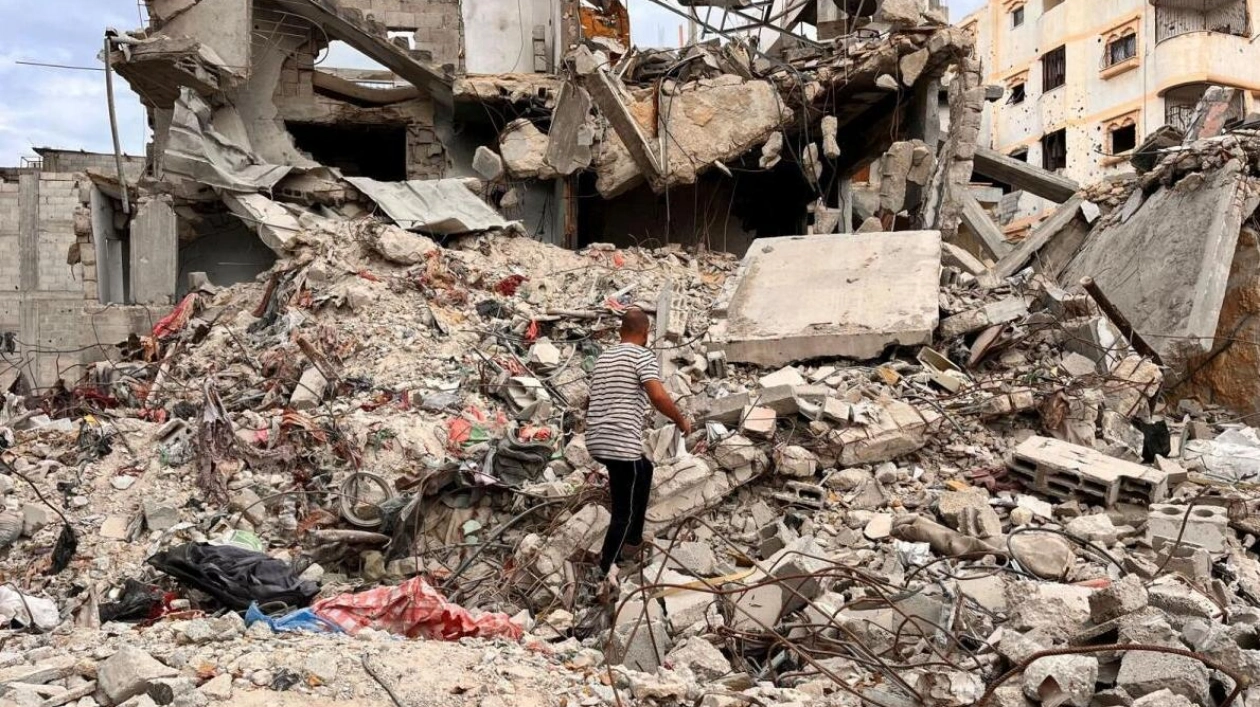Moein Abu Odeh, a Palestinian man, rummages through the debris of a house obliterated during the Israeli military offensive in Khan Younis, located in the southern Gaza Strip, on November 18, 2024. — Reuters
Abdelrahman Abu Anza's family home in the war-torn southern Gaza has been reduced to rubble. Now, the Palestinian man is utilizing the debris to construct a shelter to shield himself from the winter chill. According to the United Nations' humanitarian agency OCHA, Israeli bombardments over the past 13 months have resulted in 'more than 70 percent of civilian housing... either damaged or destroyed'. With numerous residents of the Gaza Strip displaced by the conflict, often seeking refuge in tent camps, the impending winter poses a significant concern.
Some, like Abu Anza, have resorted to building makeshift homes using shattered concrete from war-damaged buildings and traditional methods to create mortar. Surrounded by wreckage in Khan Yunis, southern Gaza's principal city, Abu Anza informed AFP that 'our home was very old, it was built in 1936.' By mixing clay sand with water to make mortar, Abu Anza stated that he was 'able to gather these stones to rebuild a wall to protect us, and then we will rebuild the entire house'. Others are also hastily preparing shelters with limited resources, bracing for the cold winter nights in the besieged territory, where temperatures can plummet to around 6 degrees Celsius (42 Fahrenheit).
Last year, a few months into the war, heavy rains inundated the tents of hundreds of thousands of displaced individuals, leaving them even more susceptible to the coastal territory's humid nights. Although temperatures never drop below zero degrees Celsius, nighttime humidity permeates clothing, creating a damp sensation that is difficult to eradicate in such precarious living conditions. Even before the war, triggered by the Palestinian militant group Hamas's October 7, 2023 attack, an Israeli blockade meant that very little building material entered Gaza. Israeli authorities have severely restricted cement imports, for instance, fearing that armed groups would use it to construct tunnels for military purposes. Now, it is virtually banned, despite appeals from several aid groups since the summer to include construction material in the list of products permitted into Gaza.
'There is no cement, so the alternative is that we revert to how it was 70 years ago, to the time of our ancestors, building with clay,' said Muhammad Shanino, whose three-story home had been demolished. 'They have thrust us back into a primitive life,' he remarked, gesturing to a wall composed of mismatched building blocks, roughly mortared. The Global Shelter Cluster coalition of aid groups stated that 'when possible, repairing existing houses is the most effective approach' to prepare for winter. Shanino said he had utilized around 700 stones from his ruined home to construct a modest shelter, where his family now shares a single room. With a corrugated metal sheet and tarps for a roof, a window covered only by a thin piece of fabric, and walls riddled with cracks, their dwelling remains exposed to the elements. And although it is significantly smaller than the house they once lived in, 'my children say it's warmer than a tent,' Shanino added.
Social media users have shared videos of makeshift homes, lauding Gazans' ingenuity and resilience as they endure dire humanitarian conditions. Beyond the widespread destruction, Israel's military campaign has claimed the lives of at least 43,922 people in Gaza, the majority of whom were civilians, according to figures from the Hamas-run territory's health ministry, which the United Nations deems reliable. The Hamas attack on Israel that preceded it resulted in 1,206 fatalities, mostly civilians, according to an AFP tally of Israeli official figures. Palestinian woman Nidaa al-Jarn expressed gratitude for having a shelter. Standing barefoot in a makeshift room 'made of stones we took from demolished houses and reclaimed, and built with mud', Jarn said she had constructed it 'because we want to live'.
Source link: https://www.khaleejtimes.com






